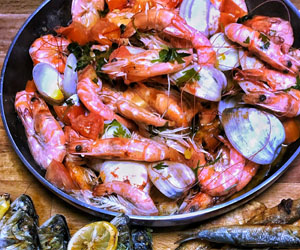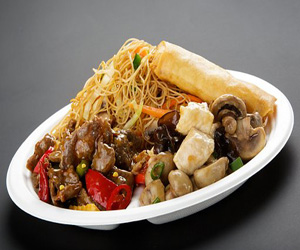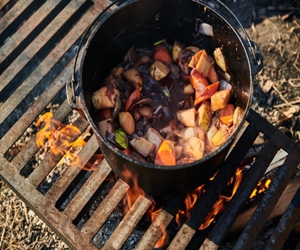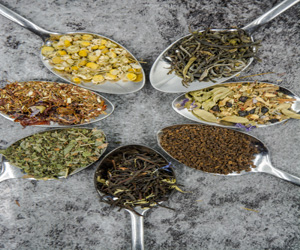



The Mediterranean diet is celebrated worldwide for its remarkable health benefits and tantalizing flavors. At the heart of this renowned diet lies a collection of time-honored cooking methods that transform simple ingredients into culinary masterpieces. Let's take a journey through the Mediterranean and unlock the secrets of its cooking methods.
1. Grilling And Roasting: One of the most cherished Mediterranean cooking techniques is grilling. The process of cooking food over an open flame or on a grill imparts a distinct smoky flavor. From fresh fish to succulent lamb, Mediterranean cuisine boasts a wide range of grilled delicacies. Vegetables like eggplant, bell peppers, and zucchini are also commonly grilled and then drizzled with extra virgin olive oil, enhancing their natural sweetness. Roasting, often done in a wood-fired oven, is another prevalent method that intensifies the flavors of dishes.
2. Olive Oil: The Mediterranean diet is synonymous with olive oil. This liquid gold is not just an ingredient; it's a cooking method in its own right. Olive oil is used for sautéing, frying, and as a dressing for salads. It imparts a delightful richness to dishes and is an essential component of Mediterranean cuisine.
3. Slow Cooking: Slow cooking is a hallmark of Mediterranean cuisine. Stews and braised dishes are prepared with patience and love, allowing flavors to meld together harmoniously. Iconic dishes like Italian Osso Buco, Greek stifado, and Moroccan tagine exemplify the art of slow cooking.
4. Seasoning With Fresh Herbs: Mediterranean cooking methods emphasize the use of fresh herbs like basil, oregano, thyme, and rosemary. These herbs not only infuse dishes with an aromatic depth but also contribute to the health benefits of the Mediterranean diet.
5. Baking And Gratin: Baking is prevalent in Mediterranean cooking, especially for making bread and pastries. Flatbreads like pita and focaccia are baked to perfection. Gratin dishes, like the famous Greek moussaka, are layered with ingredients and baked to create a golden, bubbling delight.
6. Pickling And Fermentation: Pickling and fermentation are traditional methods of food preservation in the Mediterranean. Olives, capers, and various vegetables are often pickled, enhancing their flavors and extending their shelf life. The tangy result adds depth to salads, antipasti platters, and meat dishes.
7. Poaching And Steaming: Poaching is a gentle cooking method used for delicate ingredients like seafood. Fish, in particular, is often poached in a fragrant broth of herbs and spices. Steaming is a healthy technique employed for vegetables, ensuring they retain their nutrients and vibrant colors.
8. Using Seasonal Ingredients: Mediterranean cuisine celebrates the beauty of seasonal ingredients. Cooking with fresh, in-season produce ensures the fullest flavors and the highest nutritional value in every dish.
9. Layering Flavors: Mediterranean cooking often involves layering flavors and textures. Whether it's layering phyllo dough for baklava or layering vegetables and sauces in a lasagna, this method results in a harmonious balance of tastes and textures.
Mediterranean cooking methods are a testament to the simplicity and artistry of this world-renowned diet. The careful selection of fresh ingredients, the meticulous application of various cooking techniques, and the incorporation of time-honored traditions all contribute to the delightful, healthy, and flavorful dishes that define Mediterranean cuisine. So, next time you embark on a culinary adventure inspired by the Mediterranean, remember to embrace these cherished cooking methods to savor the true essence of this extraordinary cuisine.




A Blueprint For Healthful Eating
 Next Level: Whole Grains
Next Level: Whole Grains
Above the fruits and vegetables, whole grains take their place. These include staples like whole wheat, barley, oats, and brown rice. Whole grains are a source of complex carbohydrates and dietary fiber, providing a steady release of energy and supporting digestive health. They are also integral to Mediterranean dishes like whole wheat pasta and whole grain bread.
Healthy Fats: Olive Oil
The Mediterranean diet pyramid highlights the importance of healthy fats. At its heart is olive oil, often referred to as "liquid gold." Olive oil is the primary source of fat in this diet and is rich in monounsaturated fats, which promote heart health. It's used for cooking, dressing salads, and drizzling over dishes to enhance flavors and provide valuable health benefits.
The Culinary Comfort Of Nourishing The Soul
 One of the defining features of cozy meals is their ability to evoke a sense of nostalgia. These are the recipes that transport us back to cherished moments in our lives. A pot of simmering chili on the stove might remind us of family gatherings around the fireplace, while a bubbling pot of chicken and dumplings might evoke the comforting embrace of a grandmother's kitchen. Cozy meals are not just about eating; they are about reliving memories and creating new ones.
One of the defining features of cozy meals is their ability to evoke a sense of nostalgia. These are the recipes that transport us back to cherished moments in our lives. A pot of simmering chili on the stove might remind us of family gatherings around the fireplace, while a bubbling pot of chicken and dumplings might evoke the comforting embrace of a grandmother's kitchen. Cozy meals are not just about eating; they are about reliving memories and creating new ones.
The hallmark of cozy meals is their simplicity. These dishes often feature familiar ingredients and straightforward preparation methods. From hearty stews and creamy macaroni and cheese to chicken pot pie and slow-cooked roasts, cozy meals embrace the idea that sometimes, the most satisfying culinary experiences are the uncomplicated ones.
Cozy meals also have a remarkable ability to foster connections. They are perfect for sharing with loved ones, whether it's a romantic dinner for two or a family feast. The act of gathering around the table to enjoy a hearty, comforting meal creates an intimate bond and a sense of togetherness. It's a time to put away distractions and engage in meaningful conversations while savoring the food that warms both the body and the heart.
A Journey To Culinary Excellence
 2. Baking: Similar to roasting, baking takes place in an enclosed oven. This method is perfect for bread, pastries, and casseroles, allowing even cooking and browning.
2. Baking: Similar to roasting, baking takes place in an enclosed oven. This method is perfect for bread, pastries, and casseroles, allowing even cooking and browning.
3. Grilling: Grilling imparts a smoky flavor and beautiful grill marks on food. It's a favorite for outdoor cooking, especially for items like burgers, steaks, vegetables, and seafood.
4. Broiling: Broiling places food directly beneath the oven's heating element. It's a quick way to achieve a browned and crispy top layer, making it ideal for cheese-topped dishes and meats.
Moist Heat Cooking Methods
1. Boiling: Boiling involves immersing food in boiling water. This method is suitable for pasta, rice, vegetables, and hardier foods. It's important to note cooking times to avoid overcooking.
2. Steaming: Steaming is a gentle method that cooks food over, not in, boiling water. It preserves nutrients and flavors, making it an excellent choice for vegetables, seafood, and dumplings.
3. Poaching: Poaching involves gently simmering food in a flavorful liquid, typically at a lower temperature than boiling. This method is perfect for cooking delicate items like eggs, fish, and chicken.
 Fresh Ingredients As Key Players
Fresh Ingredients As Key Players
Flavorful plant-based cuisine places a strong emphasis on the use of fresh, seasonal ingredients. Fruits and vegetables in their prime, legumes, whole grains, nuts, and seeds form the foundation of these dishes. The freshness and quality of these ingredients not only enhance the taste but also provide a wealth of nutrients, vitamins, and minerals.
Spices And Herbs For Complexity
Spices and herbs are the secret weapons in crafting flavorful plant-based dishes. Ingredients like garlic, ginger, turmeric, cumin, coriander, and a variety of aromatic herbs are used to create layers of complexity in flavors. These natural seasonings not only add depth but also contribute to the health benefits of the dishes.
Umami-Rich Ingredients
Umami, the fifth basic taste, often associated with savory and meaty flavors, is a hallmark of many plant-based recipes. Ingredients like mushrooms, soy sauce, miso, and nutritional yeast are used to add richness and depth to dishes, giving them a satisfying and meaty taste without actual meat.
Texture And Presentation
Texture plays a significant role in the appeal of flavorful plant-based dishes. Ingredients like tofu, tempeh, seitan, and various plant-based meat substitutes offer the chewiness and mouthfeel traditionally associated with animal products.
 Flavor And Culinary Versatility
Flavor And Culinary Versatility
Natural ingredients infuse dishes with the vibrant flavors and aromas that no artificial additives can mimic. Fresh herbs, spices, and produce can elevate a simple meal into a culinary masterpiece. The versatility of these ingredients is unparalleled; they can be used to create a wide array of dishes that cater to various tastes and dietary preferences, from vegan to omnivorous.
Environmental Stewardship
Choosing natural ingredients is not only beneficial for your health but also for the environment. These ingredients are cultivated with minimal synthetic pesticides and fertilizers, reducing the carbon footprint of your diet. Moreover, supporting sustainable farming practices helps preserve biodiversity, conserve natural resources, and mitigate soil and water pollution. By opting for natural, organic, and locally sourced ingredients, you play a crucial role in the global movement towards sustainable agriculture and food systems.
A World Of Perfection In A Tiny Cup
 For an espresso aficionado, the journey begins with selecting the finest coffee beans. They meticulously examine the origin, variety, and roast level, knowing that these factors will greatly influence the resulting shot. It's not just about caffeine; it's about the nuances and subtleties in flavor. Beans from Ethiopia offer a different experience than those from Colombia, and an espresso aficionado savors each distinctive profile.
For an espresso aficionado, the journey begins with selecting the finest coffee beans. They meticulously examine the origin, variety, and roast level, knowing that these factors will greatly influence the resulting shot. It's not just about caffeine; it's about the nuances and subtleties in flavor. Beans from Ethiopia offer a different experience than those from Colombia, and an espresso aficionado savors each distinctive profile.
Grinding the beans is a science in itself. The grind size must be just right, neither too fine nor too coarse, to achieve the perfect extraction. Precision is key, and aficionados invest in top-notch grinders that allow for minute adjustments. They know that a slight tweak can transform a mediocre shot into an exceptional one.
The espresso machine is their prized possession. It's a piece of equipment they've researched extensively, chosen carefully, and maintain lovingly. Every aspect of the machine, from the water temperature to the pressure, is controlled with meticulous care. Brewing an espresso shot is a performance, with the barista as the conductor and the machine as the orchestra.
Timing is everything. The duration of the shot, often measured in seconds, is closely monitored. Espresso aficionados understand that a few seconds too short or too long can make all the difference in flavor and aroma. It's a delicate balance, and they have it down to a precise science.